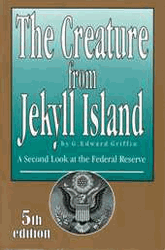This is the sixteenth installment in a series of chapter summaries from G. Edward Griffin’s must-read book The Creature From Jekyll Island. This book may be the most important “red pill” available and we highly recommend that you read the full book. Buy it today at RealityZone.
G. Edward Griffin
 |
| Buy Here |
Chapter 16 Summary: The Creature Comes to America
America had its first central bank even before the Constitution was drafted. It was called the Bank of North America and was chartered by the Continental Congress in 1781. Modeled after the Bank of England, it was authorized to issue more paper promissory notes than it held in deposits. In the beginning, these notes were widely circulated and served as a national currency. Although the bank was essentially a private institution, it was designed for the purpose of creating money to lend to the federal government, which it did from the start.
The Bank of North America was riddled with fraud, and it quickly fell into political disfavor. Its inflated bank noted eventually were rejected by ordinary citizens and ceased to circulate outside of the Bank’s home in Philadelphia. Its charter was allowed to expire and, in 1783, it was converted into a purely commercial bank chartered by the state of Pennsylvania.
The advocates of fiat money did not give up. In 1791, the First Bank of the United States (America’s second central bank) was created by Congress. The new bank was a replica of the first, including fraud. Private investors in the Bank were among the nation’s most wealthy and influential citizens, including some Congressmen and Senators. But the largest investment and the most powerful influence in the new Bank came from the Rothschilds in Europe.
The bank set about immediately to serve its function of creating money for the government. This led to a massive inflation of the money supply and rising prices. In the first five years, 42% of everything people had saved in the form of money was confiscated through the hidden tax called inflation. This was the same phenomenon that had plagued the colonies less than two decades earlier, but instead of being caused by printing-press money, it was now fueled by fractional-reserve bank notes created by the central bank.
As the time for renewal of the Bank’s charter approached, two groups with opposite intentions became strange political allies against it: the Jeffersonians who wanted sound money; and the frontier banks, called wildcatters, who wanted unlimited license to steal. On January 24, 1811, the charter was defeated by one vote in the Senate and one in the House. The central bank was gone, but the wildcatters were everywhere.
The War of 1812 was not popular among the American public, and funding would have been impossible through taxes alone. The government chose to fund the war by encouraging wildcat banks to purchase its war-debt bonds and convert them into bank notes which the government then used to purchase war material. Within two years the nation’s money supply had tripled, and so had prices. Once again, the monetary and political scientists had succeeded in fleecing the American public of approximately 66% of all the money they held during that period. And that was on top of the 42% fleecing they got a few years earlier by the Bank of the the United States.
**Stay tuned for next week’s summary of chapter 17: A Den of Vipers
Get the book for yourself or for others you want to wake up. It reads like a mystery novel and is filled with colorful metaphors that make the seemingly complex world of banking very easy to comprehend. Visit RealityZone for your copy today. Summary is re-printed with permission from G. Edward Griffin.
See other parts below:
PART 1: The Journey to Jekyll Island
PART 2: The Name of the Game is Bailout
PART 3: Protectors of the Public
PART 4: Home, Sweet Loan
PART 5: Nearer to the Heart’s Desire
PART 6: Building the New World Order
PART 7: The Barbaric Metal
PART 8: Fool’s Gold
PART 9: The Secret Science
PART 10: The Mandrake Mechanism
PART 11: The Rothschild Formula
PART 12: Sink the Lusitania!
PART 13: Masquerade in Moscow
PART 14: The Best Enemey Money Can Buy
PART 15: The Lost Treasure Map
linkwithin_text=’Related Articles:’

Be the first to comment on "G. Edward Griffin: The Creature Comes to America"